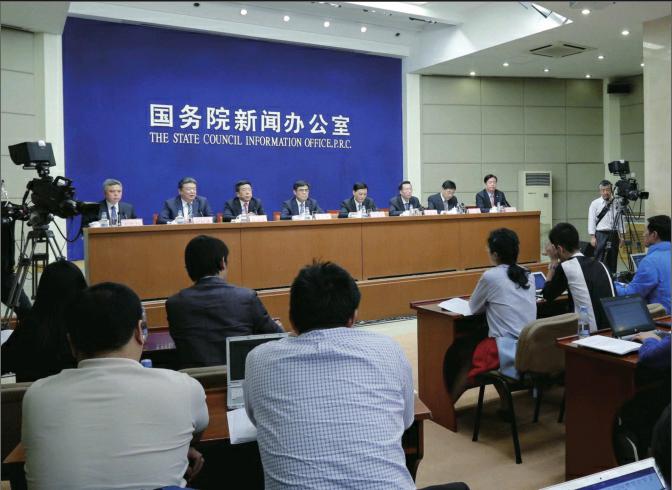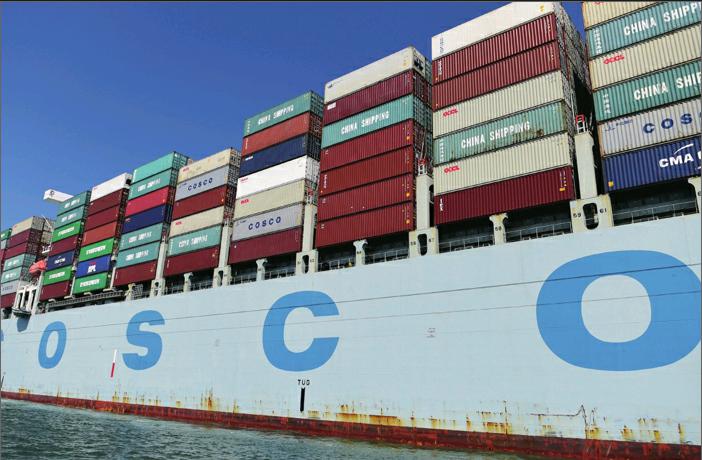Higher Profits,Faster Reform
2017-06-07ByWangJun
By+Wang+Jun


‘In the fi rst quarter centrally administered state-owned enterprises (SOEs) realized sales revenues of 6 trillion yuan (869 billion),” said Shen Ying, chief accountant of the State-Owned Assets Supervision and Administration Commission (SASAC) of the State Council. Speaking at a press conference on April 13, Shen added that SOE revenues went up 19.2 percent, and their net profi ts totaled 312 billion yuan ($45.2 billion), a year-onyear increase of 23.2 percent.
Industrial analysts think that the rise in revenues and profi ts indicates that the 102 SOEs overseen by the SASAC of the State Council, collectively known as centrally administered SOEs, may have completed a six-year readjust- ment period caused by overcapacity reduction and defl ation and entered a new development cycle.
On the same day, Yan Pengcheng, spokesman for the National Development and Reform Commission (NDRC), revealed that the scheme of the second round of the mixed-ownership reform in SOEs will soon be approved, and that the government is selecting more SOEs to incorporate private shareholders.
Performance improvement
Shen said that among the 102 centrally administered SOEs, 91 saw their revenues grow and 54 of them saw a rise of 10 percent or above from January to March 2017; 99 generated prof- its in the same period and 81 saw their profi ts multiply, with 43 having gains of 10 percent or above. During the fi rst quarter of this year, the net profi ts of those companies totaled 226.42 billion yuan ($32.8 billion), up 26.5 percent over a year ago.
These developments are due to the recovery of traditional sectors such as the petrochemical, steel and coal industries. Shen said that the oil and petrochemical, iron and steel, and coal sectors saw their revenues surge by over 40 percent, and their profi t margins were also improving.
These industries were also among those with the fastest growth rates of ex-factory prices in the first quarter. According to figures from the National Bureau of Statistics (NBS), the industries of oil and natural gas exploitation, coal mining and washing, as well as ferrous metals smelting and rolling registered growth at 70.1, 39.2 and 38.2 percent, respectively.
“Centrally administered SOEs have taken advantage of recent price hikes of bulk commodities by intensifying production,” Shen said.
“Previously performance of centrally administered SOEs had been seriously affected by fl uctuations in bulk commodity prices in the international market. Profits were particularly affected by the decline of steel, coal and oil prices in recent years,” Hao Yufeng, head of the Research Department of the China Enterprise Confederation, said in an interview with National Business Daily. “Currently bulk commodity prices are rebounding. This is expected to support profit growth of centrally administered SOEs during 2017.”
Hao believes that in order to fundamentally improve their business performance, centrally administered SOEs must carry out institutional reforms to foster new growth drivers.
Besides the price hikes of bulk commodities, the better performance of centrally administered SOEs in the first quarter could also be attributed to their efforts to conduct reorganizations and restructuring, increase the efficiency of resource allocation and reduce management costs, Shen said. In addition, their progress in improving internal incentive mechanisms has also played a signifi cant role.
Nonetheless, Li Jin, chief researcher of the China Enterprise Research Institute, is more concerned about the changes in the gross profit composition and business structures of centrally administered SOEs.
Li said that the proportion of power, auto and oil refining companies in the total profits of centrally administered SOEs is decreasing, and that the percentage of profi ts from energy enterprises have decreased four years in a row. On the other hand, the proportion of profits contributed by the manufacturing industry has kept increasing.
Reform progress
Yan said that since 2016, the NDRC has launched two rounds of pilot mixed-ownership reform in centrally administered SOEs. The first round involved nine companies and their reforms are expected to produce concrete outcomes within this year.
“The 10 enterprises for the second round of reform have been decided by the State Council Leading Group for SOE Reform. Of them, nine have submitted their reform programs, which will receive fi nal approval soon,” Yan added.
According to Yan, those 19 enterprises are involved in the distribution and sale of electricity, electric equipment manufacturing, high-speed railway, railway equipment manufacturing, aviation logistics, civil aviation information services, basic telecommunications services, defense, key commodities and fi nance. Seven of those chosen are part of the defense industry.
Ren Zeping, chief economist of Founder Securities Co. Ltd., believes substantial SOE reforms in key sectors will accelerate this year.
He called for more attention to enterprises likely to be included in the second and third rounds of mixed-ownership reform such as the State Grid Corp., the China Railway Corp., the China National Aviation Holding Co., the China Southern Air Holding Co. and China Telecom. In addition, enterprises in the defense industry including the Aviation Industry Corp., the China South Industries Group Corp., the China North Industries Group Corp., the China Shipbuilding Industry Corp. and the China Aerospace Science and Technology Corp., as well as the China National Salt Industry Corp. and the China National Gold Group Corp., may also participate.
“Mixed-ownership reform of the China Railway Corp. is very likely to serve as a breakthrough for the market-oriented reform of the railway sector this year,” Li told National Business Daily.
Although the China National Petroleum Corp. and some other oil companies have launched reforms in several areas this year, Yan said the mixed-ownership reform in the oil and natural gas sector will be advanced in the third round after its overall restructuring is carried out.
